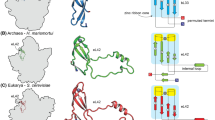Summary
An interspecies comparison was made between the 3′ ends of Balbiani ring genes fromChironomus. The comparison was focused on the BR2.2 gene, and a part at the 3′ end fromChironomus pallidivittatus (which included also a segment of the gene core) was cloned. Its sequence, and other previously published BR sequences from this species and fromChironomus tentans were used in the analysis.
The 3′ parts of these repetitive genes can be divided into a region belonging to the core of the genes followed by a terminal region. In the core region the repeats (each of which consists of a constant part and a subrepeated part) are highly similar and the constant parts show little interspecies differentiation. Furthermore, the two parts of the repeats are units in an evolutionary and probably also functional sense.
The terminal region contains modified constant units, usually isolated betwen acidic so-called cys regions, the whole arrangement lying upstream of an intron toward a 3′-terminal exon. Most of the modified constant units are mosaics in rates of evolution with stable outer quarters bordering to equally stable cys regions and a central half with a very high rate of evolution. One of the terminal units, present only in the BR2.2 gene and second from the end, differs distinctly not only from corresponding core units but also from other terminal units in the three normally active BR genes. It lies upstream of all cys regions and is evolutionarily conserved over most of its length.
Furthermore, two-dimensional protein structure prediction does not exclude an endoproteolytic cleavage site in this unit. Such a site appears unlikely in other terminal or core regions. This is of interest in view of evidence for intracellular cleavage of the BR2.2 terminal region with liberation of a part containing a DNA-binding domain (Botella et al. 1988).
All in all the fine anatomy of evolutionary changes at the BR gene termini shows interesting correlations with postulated functional relations and may have predictive value in the further functional analysis of this part of the gene.
Similar content being viewed by others
References
Bäumlein H, Pustell J, Wobus H, Case ST, Kafatos FC (1986) The 3′ ends of two genes in the Balbiani ring c locus ofChironomus thummi. J Mol Evol 24:72–82
Botella L, Grond C, Saiga H, Edström J-E (1988) Nuclear localization of a DNA-binding C-terminal domain from Balbiani ring coded secretory protein. EMBO J 7:3881–3888
Chou PY, Fasman GD (1978) Prediction of the secondary structure of proteins from their amino acid sequence. Annu Rev Biochem 47:251–276
Galler R, Rydlander L, Riedel N, Kluding H, Edström J-E (1984) Balbiani ring induction in phosphate metabolism. Proc Natl Acad Sci USA 81:1448–1452
Galler R, Saiga H, Widmer RM, Lezzi M, Edström J-E (1985) Two genes in Balbiani ring 2 with metabolically different 75S transcripts. EMBO J 4:2977–2982
Garnier J, Osguthorpe DJ, Robson B (1978) Analysis of the accuracy and implications of simple methods for predicting the secondary structure of globular proteins. J Mol Biol 120: 97–120
Grond C, Saiga H, Edström J-E (1987) The sp-I genes in the Balbiani rings ofChironomus salivary glands. In: Hennig W (ed) Structure and function of eukaryotic chromosomes. Results and problems in cell differentiation, vol 14. Springer-Verlag, Berlin, pp 69–80
Hamodrakas SJ, Kafatos FC (1984) Structural implications of primary sequences from a family of Balbiani ring-encoded proteins inChironomus. J Mol Evol 20:296–303
Höög C, Wieslander L (1984) Different evolutionary behaviour of structurally related, repetitive sequences occurring in the same Balbiani ring gene inChironomus tentans. Proc Natl Acad Sci USA 81:5165–5169
Höög C, Engberg C, Wieslander L (1986) A BR1 gene inChironomus tentans has a composite structure: a large repetitive core block is separated from a short unrelated 3′-terminal domain by a small intron Nucleic Acids Res 14:703–719
Höög C, Daneholt B, Wieslander L (1988) Tandem repeats in long repeat arrays are likely to reflect the early evolution of Balbiani ring genes. J Mol Biol 200:655–664
Lendahl U, Saiga H, Höög C, Edström J-E, Wieslander L (1987) Rapid and concerted evolution of repeat units in a Balbiani ring gene. Genetics 117:43–49
Ptashne M (1988) How eukaryotic transcriptional activators work. Nature 335:683–689
Pustell J, Kafatos FC, Wobus U, Bäumlein H (1984) Balbiani ring DNA: sequence comparisons and evolutionary history of a family of hierarchically repetitive protein-coding sequences. J Mol Evol 20:281–295
Rholam M, Nicolas P, Cohen P (1986) Precursors for peptide hormones share common secondary structures forming features at the proteolytic processing sites. FEBS Lett 207:1–6
Saiga H, Grond C, Schmidt ER, Edström J-E (1987) Evolutionary conservation of the 3′ ends of members of a family of giant secretory protein genes inChironomus pallidivittatus. J Mol Evol 25:20–28
Saiga H, Botella L, Edström J-E (1988) Subrepeats within the BRIβ repeat unit inChironomus pallidivittatus can be classified into different types depending on codon usage. J Mol Evol 27:298–302
Sanger F, Nicklen S, Coulson AR (1977) DNA sequencing with chain terminating inhibitors. Proc Natl Acad Sci USA 74: 5463–5468
Wieslander L, Lendahl U (1983) The Balbiani ring 2 gene inChironomus tentans is built from two types of tandemly arranged major repeat units with common evolutionary origin. EMBO J 2:1169–1175
Wieslander L, Höög C, Höög J-O, Jörnvall H, Lendahl U, Daneholt B (1984) Conserved and non-conserved structures in the secretory proteins encoded in the Balbiani ring genes ofChironomus tentans. J Mol Evol 20:304–312
Author information
Authors and Affiliations
Rights and permissions
About this article
Cite this article
Silva, F.J., Botella, L.M. & Edström, JE. Functional analysis of the 3′-terminal part of the Balbiani ring 2.2 gene by interspecies sequence comparison. J Mol Evol 31, 221–227 (1990). https://doi.org/10.1007/BF02109499
Received:
Revised:
Accepted:
Issue Date:
DOI: https://doi.org/10.1007/BF02109499




